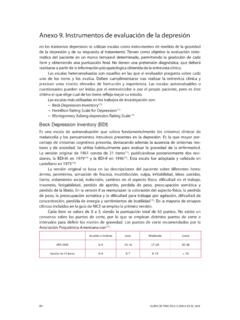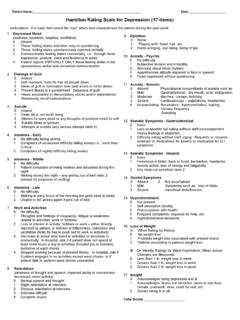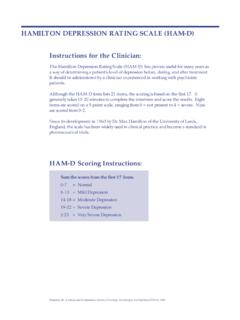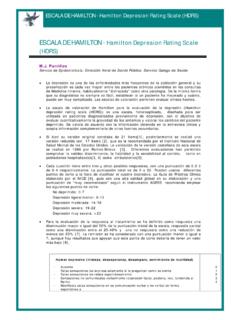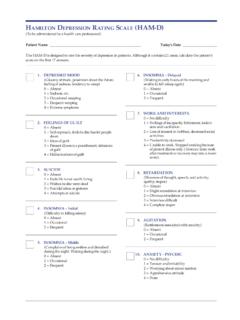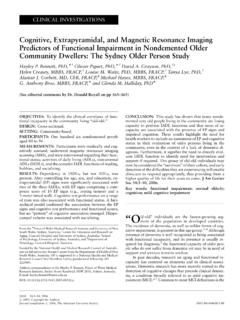Transcription of CONSUMER MEDICINE INFORMATION - Medsafe
1 Lexapro Data Sheet 31 July 2014 v2. Name of MEDICINE Lexapro . Escitalopram (as oxalate) Film-coated tablets 10 mg and 20 mg Presentation Lexapro 10 mg tablets are oval, white, scored, film-coated tablets marked with "E and L" on one side. Lexapro 20 mg tablets are oval, white, scored, film-coated tablets marked with "E and N" on one side. Uses Actions Biochemical and behavioural studies have shown that escitalopram is a potent inhibitor of serotonin (5-HT)-uptake (in vitro IC50 2nM). The antidepressant action of escitalopram is presumably linked to the potentiation of serotonergic activity in the central nervous system (CNS) resulting from its inhibitory effect on the reuptake of 5- HT from the synaptic cleft. Escitalopram is a highly selective Serotonin Reuptake Inhibitor (SSRI). On the basis of in vitro studies, escitalopram had no, or minimal effect on noradrenaline (NA), dopamine (DA) and gamma- amino butyric acid (GABA) uptake. In contrast to many tricyclic antidepressants and some of the SSRIs, escitalopram has no or very low affinity for a series of receptors including 5-HT1A, 5-HT2, DA D1 and DA D2 receptors, 1-, 2-, - adrenoceptors, histamine H1, muscarine cholinergic, benzodiazepine, and opioid receptors.
2 A series of functional in vitro tests in isolated organs as well as functional in vivo tests have confirmed the lack of receptor affinity. Escitalopram has high affinity for the primary binding site and an allosteric modulating effect on the serotonin transporter. Allosteric modulation of the serotonin transporter enhances binding of escitalopram to the primary binding site, resulting in more complete serotonin reuptake inhibition. Escitalopram is the S-enantiomer of the racemate (citalopram) and is the enantiomer to which the therapeutic activity is attributed. Pharmacological studies have shown that the R-enantiomer is not inert but counteracts the serotonin-enhancing properties of the S-enantiomer in citalopram. In healthy volunteers and in patients escitalopram did not cause clinically significant changes in vital signs, ECGs, or laboratory parameters. S-demethylcitalopram, the main plasma metabolite, attains about 30% of parent compound levels after oral dosing and is about 5-fold less potent at inhibiting 5-HT reuptake than escitalopram in vitro.
3 It is therefore unlikely to contribute significantly to the overall antidepressant effect. Pharmacokinetics Absorption Data specific to escitalopram are unavailable. Absorption is expected to be almost complete and independent of food intake (mean Tmax is 4 hours after multiple dosing). While the absolute bioavailability of escitalopram has not been studied, it is unlikely to differ significantly from that of racemic citalopram (about 80%). Page 1 of 20. Lexapro Data Sheet 31 July 2014 v2. Distribution The apparent volume of distribution (Vd, /F) after oral administration is about 12 to 26 L/kg. The binding of escitalopram to human plasma proteins is independent of drug plasma levels and averages 55%. Biotransformation Escitalopram is metabolised in the liver to the demethylated and didemethylated metabolites. Alternatively, the nitrogen may be oxidised to form the N-oxide metabolite. Both parent and metabolites are partly excreted as glucuronides. Unchanged escitalopram is the predominant compound in plasma.
4 After multiple dosing the mean concentrations of the demethyl and didemethyl metabolites are usually 28-31% and < 5% of the escitalopram concentration, respectively. Biotransformation of escitalopram to the demethylated metabolite is mediated by a combination of CYP2C19, CYP3A4 and CYP2D6. Elimination The elimination half-life (t ) after multiple dosing is about 30 hours and the oral plasma clearance (Cloral) is about L/min. Escitalopram and major metabolites are, like racemic citalopram, assumed to be eliminated both by the hepatic (metabolic) and the renal routes with the major part of the dose excreted as metabolites in urine. Approximately of escitalopram is eliminated unchanged in urine and as the S- demethylcitalopram metabolite based on 20 mg escitalopram data. Hepatic clearance is mainly by the P450 enzyme system. Linearity The pharmacokinetics of escitalopram are linear over the clinical dosage range. Steady state plasma levels are achieved in about 1 week.
5 Average steady state concentrations of 50 nmol/L (range 20 to 125 nmol/L) are achieved at a daily dose of 10 mg. Reduced hepatic function In patients with mild or moderate hepatic impairment (Child-Pugh Criteria A and B), the half-life of escitalopram was about twice as long and the exposure was about 60% higher than in subjects with normal liver function (see Precautions and Dosage and Administration). Reduced renal function While there is no specific data, the use of escitalopram in reduced renal function may be extrapolated from that of racemic citalopram. Escitalopram is expected to be eliminated more slowly in patients with mild to moderate reduction of renal function with no major impact on the escitalopram concentrations in serum. At present no INFORMATION is available for the treatment of patients with severely reduced renal function (creatinine clearance < 20 mL/min). Elderly patients (> 65 years). Escitalopram pharmacokinetics in subjects > 65 years of age were compared to younger subjects in a single-dose and a multiple-dose study.
6 Escitalopram AUC and half-life were increased by approximately 50% in elderly subjects, and Cmax was unchanged. 10 mg is the recommended dose for elderly patients. Gender In a multiple-dose study of escitalopram (10 mg/day for 3 weeks) in 18 male (9 elderly and 9 young). and 18 female (9 elderly and 9 young) subjects, there were no differences in AUC, Cmax and half-life between the male and female subjects. No adjustment of dosage on the basis of gender is needed. Polymorphism It has been observed that poor metabolisers with respect to CYP2C19 have twice as high a plasma concentration of escitalopram as extensive metabolisers. No significant change in exposure was observed in poor metabolisers with respect to CYP2D6 (see Dosage and Administration). Page 2 of 20. Lexapro Data Sheet 31 July 2014 v2. Clinical Trials Major depression Two fixed-dose studies and one flexible-dose study have shown escitalopram in the dose range 10 - 20 mg/day to be more efficacious than placebo in the treatment of depression .
7 All three studies were randomised, double-blind, parallel-group, placebo-controlled multicentre studies. Two of the studies included an active reference (citalopram). All three studies consisted of a 1-week single-blind placebo lead-in period followed by an 8-week double-blind treatment period. Patients were required to have depression with a minimum score of 22 on the Montgomery- sberg depression Rating Scale (MADRS) at both the screening and baseline visits. The MADRS consists of 10 items that measure core symptoms of depression , such as sadness, tension, pessimism and suicidal thoughts. Each item is rated on a scale of 0 (no abnormality) to 6 (severe). The populations studied were therefore defined as suffering from moderate to severe depression (mean MADRS. score 29). A total of 591 patients received escitalopram in these studies. All three studies showed escitalopram to be statistically significantly superior to placebo on the ITT. LOCF analysis of the mean change from baseline in the MADRS total score (p ).
8 The magnitude of the difference between escitalopram and placebo in the MADRS change score ranged from to (mean of these values: ). The magnitude of the difference for citalopram ranged from to (mean of these values: ). The magnitude of the difference is larger with escitalopram than with citalopram. Escitalopram demonstrated a significant early difference compared to placebo from week 2 onwards on the MADRS (week 1 in observed cases analysis). Likewise, the Clinical Global Impression . Improvement items (CGI-I) differed significantly from placebo from week 1 onwards. These early differences were not seen with racemic citalopram. In the study with two parallel escitalopram dose groups, analysis of subgroups of patients showed a trend towards greater improvement in patients with severe major depressive disorder (HAM-D > 25). receiving 20 mg/day as compared to 10 mg/day. The Hamilton Rating Scale for depression (HAM-D). consists of 17 to 24 items reflecting core symptoms of depression .
9 Each item is scored on a 3, 4, or 5 point scale with 0 reflecting no symptoms and higher scores reflecting increasing symptom severity. In a fourth flexible-dose study with a similar design, the primary analysis did not distinguish a significant drug/placebo difference for either escitalopram or citalopram over 8 weeks on the MADRS. change score in the LOCF dataset. However, on the basis of the OC analysis, both escitalopram and citalopram were significantly better than placebo (p ; difference between escitalopram and placebo: ). Escitalopram demonstrated efficacy in the treatment of anxiety symptoms associated with depression . In the three positive double-blind placebo-controlled studies escitalopram was shown to be effective compared to placebo on the MADRS anxiety items; inner tension and sleep disturbances. Furthermore, in the one study where the Hamilton Anxiety Scale (HAM-A) and the anxiety factor of the Hamilton depression Rating Scale (HAM-D scale) were used, results have shown that escitalopram was significantly better than placebo.
10 In a relapse prevention trial, 274 patients meeting (DSM-IV) criteria for major depressive disorder, who had responded during an initial 8-week open-label treatment phase with escitalopram 10 or 20 mg/day, were randomised to continuation of escitalopram at the same dose, or to placebo, for up to 36 weeks of observation for relapse. Response during the open-label phase was defined as a decrease of the MADRS total score to 12. Relapse during the double-blind phase was defined as an increase of the MADRS total score to 22, or discontinuation due to insufficient clinical response. Patients receiving continued escitalopram experienced a significantly longer time to relapse over the subsequent 36 weeks compared to those receiving placebo (26% vs. 40%; hazard ratio= , p= ). Further evidence of long-term efficacy is provided in a 6-month study, which compared escitalopram 10 mg/day to citalopram 20 mg/day over a 6-month treatment period. Analysis of the primary endpoint (the development of the MADRS total scores over 24 weeks) demonstrated escitalopram to be at least as efficacious as citalopram in the long-term treatment of depression .










